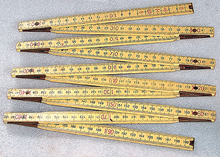Zigzag

Drawing of a zig-zag.
A zigzag is a pattern made up of small corners at variable angles, though constant within the zigzag, tracing a path between two parallel lines; it can be described as both jagged and fairly regular.
From the point of view of symmetry, a regular zigzag can be generated from a simple motif like a line segment by repeated application of a glide reflection.
The origin of the word is unclear. Its first printed appearance was in French books in the late 17th century.[1]
Contents
1 Examples of zigzags
2 See also
3 References
4 Bibliography
Examples of zigzags

A 2-metre carpenter's ruler with centimetre divisions
Lightning and other electrical hazards are often depicted with a zigzag design, with long downward strokes and short backward ones.
The trace of a triangle wave or a sawtooth wave is a zigzag.
Pinking shears are designed to cut cloth or paper with a zigzag edge, to lessen fraying.
A carpenter's folding ruler can be folded to look like a zigzag.
Zigzags are a basic decorative pattern used on pottery, and are often seen in the cuts which separate pieces of ravioli pasta.
In sewing, a zigzag stitch is a machine stitch in a zigzag pattern.
The zigzag arch is an architectural embellishment used in Islamic, Byzantine, Norman and Romanesque architecture.[2][3]
The stripe on Charlie Brown's infamous yellow shirt is indeed a zigzag.
See also
- Serpentine shape
References
^ Google Books: "Word Origins and how we know them"
^ Allen, Terry (1986). "4". A Classical Revival in Islamic Architecture. Wiesbaden..mw-parser-output cite.citationfont-style:inherit.mw-parser-output .citation qquotes:"""""""'""'".mw-parser-output .citation .cs1-lock-free abackground:url("//upload.wikimedia.org/wikipedia/commons/thumb/6/65/Lock-green.svg/9px-Lock-green.svg.png")no-repeat;background-position:right .1em center.mw-parser-output .citation .cs1-lock-limited a,.mw-parser-output .citation .cs1-lock-registration abackground:url("//upload.wikimedia.org/wikipedia/commons/thumb/d/d6/Lock-gray-alt-2.svg/9px-Lock-gray-alt-2.svg.png")no-repeat;background-position:right .1em center.mw-parser-output .citation .cs1-lock-subscription abackground:url("//upload.wikimedia.org/wikipedia/commons/thumb/a/aa/Lock-red-alt-2.svg/9px-Lock-red-alt-2.svg.png")no-repeat;background-position:right .1em center.mw-parser-output .cs1-subscription,.mw-parser-output .cs1-registrationcolor:#555.mw-parser-output .cs1-subscription span,.mw-parser-output .cs1-registration spanborder-bottom:1px dotted;cursor:help.mw-parser-output .cs1-ws-icon abackground:url("//upload.wikimedia.org/wikipedia/commons/thumb/4/4c/Wikisource-logo.svg/12px-Wikisource-logo.svg.png")no-repeat;background-position:right .1em center.mw-parser-output code.cs1-codecolor:inherit;background:inherit;border:inherit;padding:inherit.mw-parser-output .cs1-hidden-errordisplay:none;font-size:100%.mw-parser-output .cs1-visible-errorfont-size:100%.mw-parser-output .cs1-maintdisplay:none;color:#33aa33;margin-left:0.3em.mw-parser-output .cs1-subscription,.mw-parser-output .cs1-registration,.mw-parser-output .cs1-formatfont-size:95%.mw-parser-output .cs1-kern-left,.mw-parser-output .cs1-kern-wl-leftpadding-left:0.2em.mw-parser-output .cs1-kern-right,.mw-parser-output .cs1-kern-wl-rightpadding-right:0.2em
^ Allen, Terry (2008). Pisa and the Dome of the Rock (electronic publication) (2nd ed.). Occidental, California: Solipsist Press. ISBN 0-944940-08-0. Retrieved January 28, 2012.
Bibliography
Wedgwood, Hensleigh (1855). "On Roots mutually connected by reference to the term Zig-zag". Transactions of the Philological Society (2).
| Wikimedia Commons has media related to Zigzags. |
